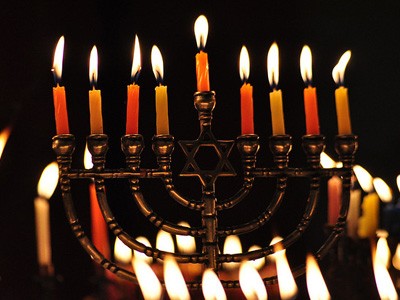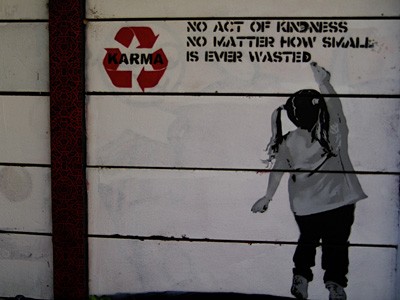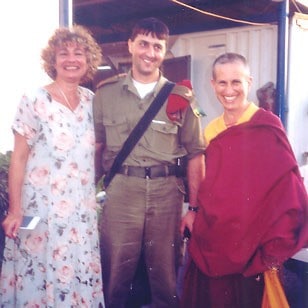Reflections of a Jewish Buddhist

In The Jew in the Lotus, Rabbi Zalman Schachter-Shalomi says he would like to request the Dalai Lama, “Give me a Dharma talk addressed to Jews.” To me, it seemed he was saying, “Give me something of your belief system that speaks to me—that works for me.” Judaism speaks to Reb Zalman, of course, but he wanted to expand his outlook. In my case, although I grew up Jewish, I didn’t always grasp the real meaning of the familiar traditions. But after I began to study and practice Buddhism, I came to understand in a new way the Jewish rituals I had learned as a child.
The two traditions share a bounty of common practices. They both emphasize acting ethically and helping others. Each is based on a body of teachings passed on for thousands of years which has given rise to a flourishing intellectual culture that has fostered debate and a diversity of opinions. Each teaches respect for one’s spiritual teachers. Both emphasize that actions have consequences, but that errors can be purified or atoned for. Neither group proselytizes, though both accept newcomers. Jews and Buddhists alike treat their texts and holy objects with great care. Even some of their mystical teachings are similar: that we are reborn after we die, for example.
Certainly, at the most esoteric levels, many practices are similar. Coming from a Jewish background, I’m naturally familiar with a tradition that sets out guidelines for ethical behavior. Jews have the Ten Commandments and the 613 mitzvoth. Buddhists have the ten destructive actions, the five heinous actions, and the five precepts. The dueling numbering systems in both make me dizzy.
For me, the key difference seemed to be in the motivation. In Judaism, the answer to the question, “Why?” always came down to what was for me a monosyllabic obstacle: God. Because that’s what God said we should do. For the love of God. Out of fear of God. Because we’re God’s Chosen People. Those answers never satisfied me. I needed reasons that I could relate to in a less abstract way. While putting forth many of the same behavioral guidelines—no killing, no stealing, no adultery—Buddhism outlined reasons I was able to grasp and agree with. Principal among these is that all people—and beyond that, all sentient beings—have the same wish: to be happy and not to suffer. Furthermore, my actions have consequences. When I engage in an action that brings negative consequences to myself or others, that action is labeled negative. So avoiding killing, stealing, adultery, and so on are suggested because following these guidelines avoids harm to ourselves and others.
His Holiness the Dalai Lama describes the fundamental message of Buddhism this way: “Be helpful to others. If you can’t help, at least don’t harm them.” While growing up, I didn’t hear so much about others. So as an adult, when I began to see my actions in terms of their effects on others, I thought this was something alien to Judaism. Until, that is, I met a scholarly Orthodox Jewish relative of mine on a recent trip to Israel. During a conversation on the fundamental points of Judaism, he told me a story: A man once asked, “Can you tell me the entire message of Judaism while standing on one foot?” The answer: “Love thy neighbor as thyself.”
It gave me chills! Suddenly, as I remembered the Dalai Lama’s nutshell description of Buddhism, I heard that familiar phrase in a whole new way. It brought me a great sense of joy to realize that in Judaism, too, being other-focused was a key.
Still, there’s a dichotomy in terms of how far the two traditions go in the direction of regard for others. In Judaism, many prayers end with “…peace for all Israel.” Not peace on Earth, not peace for all, not peace for all men even, just peace for Israel. At some point, that phrase began to trouble me. “Why only Israel?” I thought. Is that enough? Should Israel be at peace while everyone else is in chaos? Invariably, the answer to that question was that we Jews need to look out for ourselves. After all, if we didn’t, who would?
Buddhism takes a different view. Prayers are dedicated not to God, the Buddha, or a deity, but for the benefit of all sentient beings. The Buddha taught that wishing selfishly for only our own immediate happiness ironically brings misery, while wishing to benefit others invariably leads to happiness. Wishing for our own happiness is fine—that’s exactly what the determination to be free from suffering and to attain liberation are all about. It’s selfishly seeking our own immediate, worldly happiness that brings the problems because it makes us obsess about things in our life in an unhealthy way.
While Buddhism puts more emphasis on all sentient beings, I believe a similar message exists in Judaism, too, within the beautiful phrase, “Love thy neighbor as thyself.” Also, Jews teach that the mission they were chosen for by God is tikkun olam, usually translated as repair of the world. But tikkun can also mean “to improve,” and olam can be translated expansively as “the universe.”
In each tradition, the individual plays a personal role in bringing about the betterment of others. As a child, I wondered why we needed to say blessings before we ate various foods, and why there were blessings for things like hand-washing, candle-lighting, and enjoying new things. When I was very young—six or seven—I enjoyed saying the blessings and even did them at home. But after my bar mitzvah, it stopped making sense to me, and so I stopped. Sometimes it seemed odd that God wanted so much praise, while other times, the blessings seemed like a lot of superstition. Whether it was because of my own poor intelligence or lack of insight, or perhaps because I never completed my Jewish education, I got stuck.
It wasn’t until I encountered Buddhism that the brachas made sense to me. Some Buddhists practice “thought transformation”—a mental exercise in which we mentally transform all actions and circumstances for the benefit of all beings. The simple act of opening a door becomes the thought, “I am opening the door to liberation for all sentient beings.” Washing the dishes becomes, “With wisdom and compassion, I will clean the sufferings and negative emotions from the minds of all beings.”
These parallels opened my eyes to the depth of the Jewish rituals. The blessings in Judaism (And oy! There are so many of them!) are meant to lift the rather selfish act of eating, or the otherwise mundane act of washing one’s hands, into the realm of spiritual endeavor. Moment by moment, each day’s little actions become reminders of the divine.
Jewish law, or halachah, starts with one’s own actions—observing the various mitzvoth and being aware of one’s words, actions, and so on. This is done on the basis of believing in and wanting to please God, the King of the Universe. In Buddhism, improvement of the world also starts with one’s own thoughts, speech, and actions. But the difference is that one actually wants to transform oneself into someone who can benefit all sentient beings. The ultimate source of power, known as Buddha nature, is within oneself. It is not something external. The ultimate state is something that we transform ourselves into, something we can aspire to.
Thus, in the Buddhist worldview, we each have the potential to become a fully enlightened Buddha, and whether we do or not—and how we experience the world—depends on our own physical, verbal, and mental actions. Each one of us is the creator of our own experience. The Dhammapada says, “Mind is the forerunner of all things.” Or, as Thomas Byrom interpreted it in his rendering of the Dhammapada:
We are what we think.
All that we are arises with our thoughts.
With our thoughts we make the world.
Other similarities between the two faiths exist as well. In Judaism, any text containing a reference to God is to be treated with respect, out of respect for God. As students in Hebrew day school, we treated our texts reverently. If someone dropped a siddur, we would kiss it after picking it up. But again, at that time, I didn’t know why we did that. That was just what we did. Likewise, in the synagogue, people weren’t supposed to touch the Torah directly—the person reading from it kept his place by following the lines on the page with a yad (“hand”)—a long, metal wand with a hand at the end. I learned early on that if someone dropped a Torah, they were supposed to fast for forty days. I remember trying to imagine what that would feel like!
At a certain point in the Saturday morning or holiday service, someone would walk around carrying the Torah as we sang, “And this is the Torah …” and lined up to touch our books or tallises to the Torah and then kiss them. “How dumb!” I thought when I was old enough to question the practice, but not old enough to think more deeply about it. To me, it seemed a bit like idol worship.
But the same sort of reverence for texts exists in Buddhism, and now that I have some context for it, the Torah-kissing makes sense to me. It’s not anything inherent in the paper or the parchment, but in the power that comes from the knowledge within the book. In Buddhism, the same reverence is shown for Dharma texts and materials, which is why we touch the texts to our head. A friend explained it to me this way: “The Dharma is our spiritual food. Just as we wouldn’t put our food on the floor, we don’t put Dharma materials on the floor.” Similarly, old, tattered Buddhist texts are not tossed in the garbage. They are burned or stored in a safe place (or, these days, they can be recycled!). In Judaism, an old Torah scroll that cannot be repaired is buried, and according to the author Simcha Raphael, cemeteries often have specific places for burial of old sacred texts, Torah scrolls, and prayer books.
There are many levels to the teacher-student relationship in both traditions. Certainly, in some Hasidic Jewish traditions, the rebbe is regarded as being a realized authority who guides his disciples with unerring wisdom. In the Tibetan Buddhist tradition, tantric lamas are regarded in a similar way. This guru-disciple relationship is complex and is often misunderstood by Westerners, but essentially, as a means to make the student’s mind more receptive to the teachings, he or she is encouraged to imagine that the tantric lama has spiritual realizations. In some Buddhist traditions, such as the Theravada tradition, the head monk or teacher is treated with respect, but is not an object of devotion—much like the rabbi in the Reform and Conservative movements of Judaism.
Neither religion is monolithic. Within each, people practice in a variety of ways, according to their interests and dispositions. For example, just as some Jewish movements emphasize observing behavioral rules over more esoteric practices, some Buddhist traditions also put more emphasis on following ethical guidelines, while others emphasize the esoteric.
I grew up feeling happy that there was no hell in Judaism. I remember feeling smug because while my Christian friends had to worry about eternal damnation, it wasn’t on the horizon for me. Heaven, though, was an option. The Buddhist worldview speaks of other realms that can be understood as physical manifestations of one’s own state of mind. But the key is that they’re not eternal or inherently real. Buddhists believe we are born again and again, as do Jews following the Kabbalah. I was happy to learn that the Baal Shem Tov spoke of rebirth. Although rebirth was not a concept that ever caught on in mainstream Judaic thought, Simcha Raphael in Jewish Views of the Afterlife, says a belief in reincarnation gained popularity among Kabalists starting in the Middle Ages. According to Buddhism, we are born in better or worse circumstances, depending on our actions. We can purify our destructive actions through awareness of them, constructive regret, determining to avoid them in the future, and cultivating more beneficial states of mind.
Yom Kippur in Judaism serves much the same function. I especially liked the Yom Kippur tradition of tashlich—in our congregation, we would imagine putting all our wrongdoings into some bread and throw it into a river, symbolically freeing ourselves from those actions. Buddhists have similar rituals—for example, one in which we imagine our own and others’ negativities absorbing into black sesame seeds, which are then thrown into a fire. I used to think it was a shame that Yom Kippur came only once a year. It’s such a relief to feel remorse and to feel relieved of the burden! In Buddhism we try to engage in purification daily.
In some schools of Tibetan Buddhism, monastics spend hours debating points of the doctrine in an effort to refine their understanding. Various scholars and practitioners have written commentaries expressing diverse viewpoints, all of them functioning to encourage students to think and discuss themselves. Similarly, in Judaism, we find multiple commentaries and interpretations. Studying the debates of ancient rabbis spurs students to investigate and develops their discernment. The fact that each religion has encouraged such discussion throughout the centuries makes it alive today.
Valuable ideas can be shared between the two traditions. Here in Seattle, members of the Jewish and Buddhist communities have been engaged in an ongoing dialogue since 1998, hashing out common points and differences on issues such as love, suffering, and healing. Some Buddhist techniques for developing and strengthening patience, love, and compassion, for example, may be of interest to Jews, especially because these meditations do not require any particular religious beliefs. Judaism has much to offer as well—Tibetan Buddhists especially want to learn from the Jews how to keep their religion alive in exile.
On a personal level, even though my own experience has led me to Buddhism, I don’t believe that people need to change religions in order to find spiritual fulfillment. At the same time, I believe that meaningful contact with other spiritual traditions can broaden the mind, just as travel to foreign lands changes one’s perspective upon returning home. In my case, I plan to continue using my knowledge of Buddhism to increase my understanding of Judaism, and to use the beneficial values I gained from a Jewish upbringing to inspire my Buddhist practice.
Peter Aronson
Peter Aronson is an award-winning journalist with a total of two decades of experience working in radio, print, online journalism and photography. His radio work has been featured on NPR, Marketplace and Voice of America. He's produced two 30-minute radio documentaries and has won national and regional awards for his work. He's reported from the mountains of Mexico and the Moskva River, from Microsoft headquarters and from call centers in India. He traveled by canoe into the jungles of Nicaragua to report one story and climbed to a remote hilltop village in Nepal to report another. He speaks six languages, two of them fluently. He's worked as a producer-editor for MSNBC.com and as a vice president in the corporate world — in India. His photographs have been exhibited at the Museo Soumaya, the Museo de la Ciudad de Querétaro, and in New York City.


